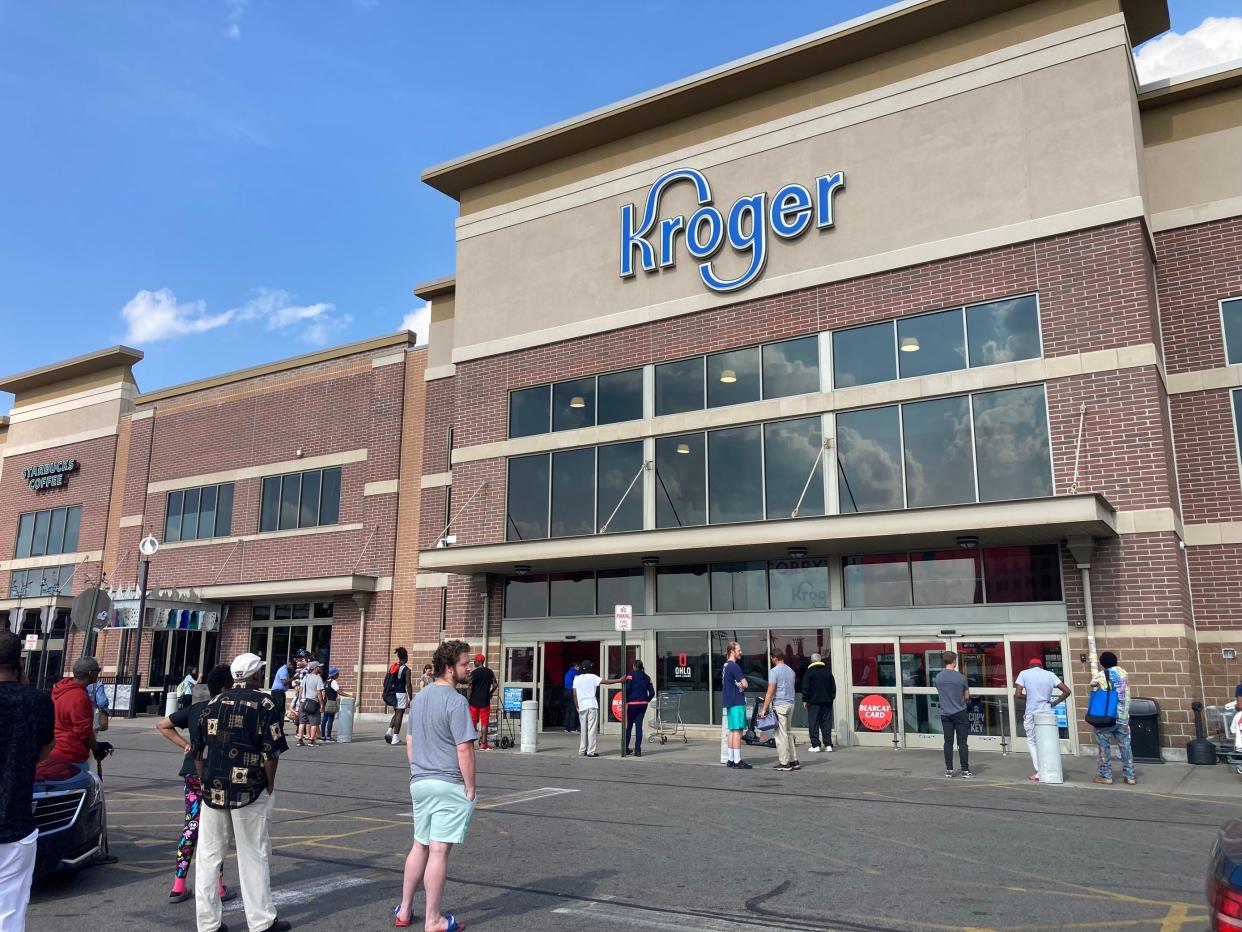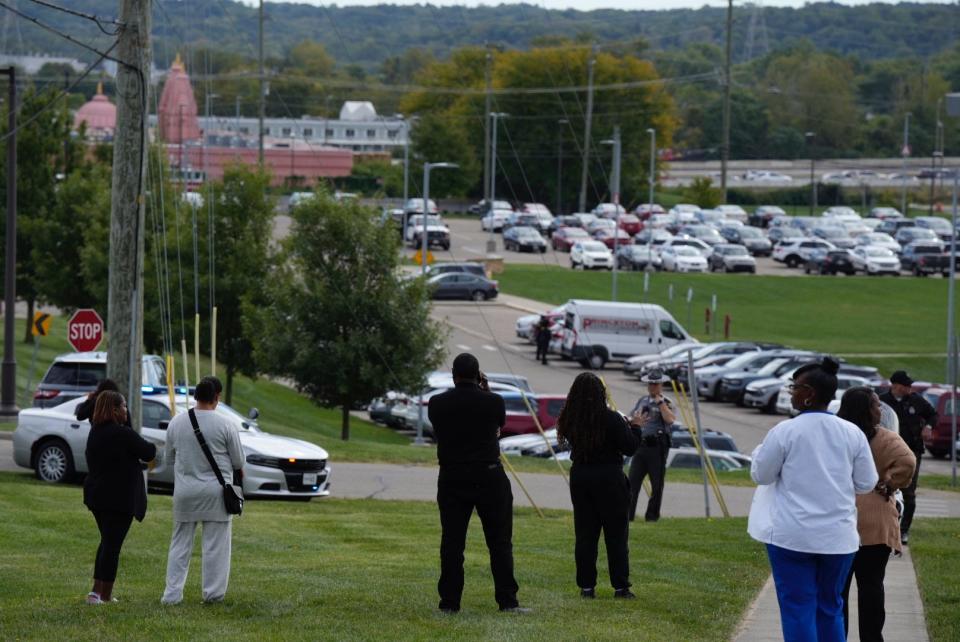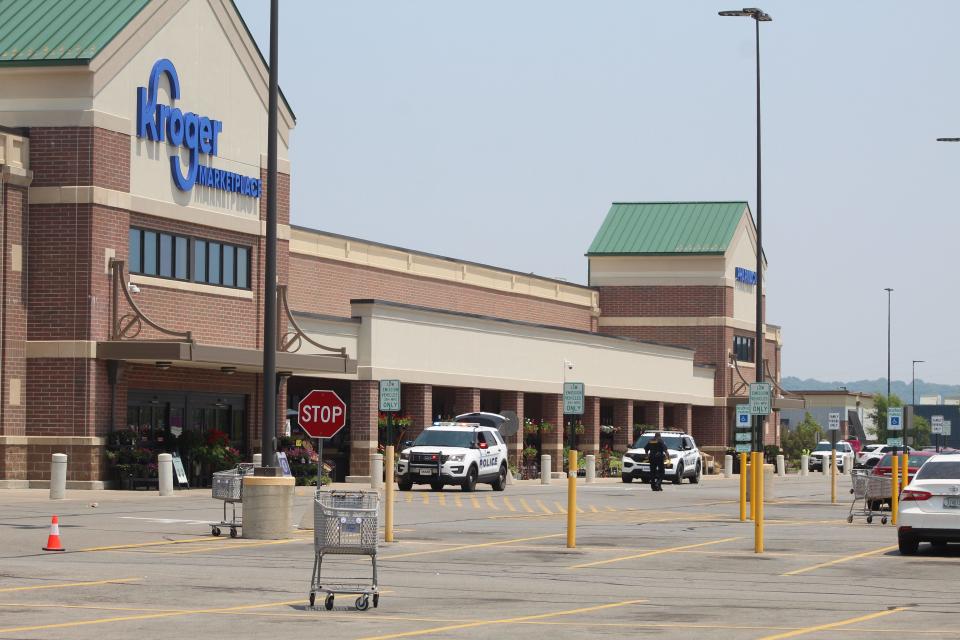Hoax or reality? Why Cincinnati's Kroger bomb threats should be taken seriously

Kathy McNay, a Clicklist employee, was in the back room at Kroger Marketplace in Newport sitting on a crate around 10:30 a.m. when she heard the announcement.
“Whatever you’re doing, wherever you are, leave it and go out the nearest exit," she remembers hearing.
“The first thing you think is, there’s someone with a gun,” she said. McNay, 71, approached another employee. “I was standing there, blanch white. He said, ‘Just leave.’”
Bomb threats: How should you respond?
It was June 10, a Saturday, at the Newport Pavilion Kroger. Newport police were dispatched at 10:31 a.m. to the store for a bomb threat call. Officers arrived at 10:34 a.m. Customers and employees flowed out of the store as ordered.
The Kroger threats in June mirror other strings of threats. On Tuesday, threats were called into two Target stores: the Anderson Township location on Beechmont Avenue and the Colerain Township location on Colerain Avenue.
McNay’s story was just one of hundreds among Kroger employees and grocery shoppers in the Northern Kentucky and Cincinnati area. Hundreds more went through the experience during Tuesday's threats.
Back in June, threats were made to five Krogers in the region: one the next day, another on June 14, and another on July 3. All were hoaxes, police say.
In Newport, Police Capt. Kevin Drohan said officers and an Airport Police Department bomb-sniffing dog searched the building.
The all-clear was issued at 12:09 p.m.
“Public safety is of utmost importance, and we have a variety of resources at our disposal to ensure it,” Drohan said. “We devote equal amounts of time and attention to investigating every incident, regardless of its validity. Should the individual or individuals be identified, we will take legal action against them to the maximum extent allowed by law.”
The FBI is aware of the hoaxes and is working with local police on investigations. False bomb threat calls, texts and posts to social media or emails are a crime, and those convicted can face five years in prison.
Bomb threats don't usually come to grocery stores. Schools are the biggest target.
Active shooter, bomb threat hoaxes: What is going on?
The Kroger and Target bomb threats are among a slew of false reports that have been happening in the past few years. There have been dozens of threats of active shooters called into schools across the country, many on the same day. There was another string of false 911 calls reporting violent crimes at new listed homes in Hamilton County earlier this year.
Law enforcement has not connected the incidents and no arrests have been publicly announced.

And yet, paramedics, law enforcement and even bomb-sniffing dogs must respond to the calls.
A 2021 U.S. Bureau of Alcohol, Tobacco, Firearms and Explosives’ Bomb Data Center report showed there were 1,876 bomb threats in the country that year, about five a day. The numbers included Homeland Security data. States may, but are not required, to report to the system. More up-to-date statistics were not available at the time of this report.
The top three targets of bomb threats that year were places of education, assembly locations like restaurants or sports arenas, and homes, the report shows.
Grocery stores didn’t make the list.
Even so, grocery stores might make sense to someone who wants to instigate chaos. “They’re soft targets with low security,” said Thomas Stucky, an Indiana University criminal justice professor and former police officer whose expertise includes communities and crime.
Threats are more common and rarely precede actual bombings
Bomb threats far outnumber actual bombings. Even though bomb threats recorded by the federal agencies documented nearly 2,000 in 2021, they recorded 381 bombings. Even that total is greater than actual bombings, though, because it includes other types of explosions, such as fireworks and commercial and military explosions.
Major casualties and destruction have been caused by bombs, though. Three people were killed and hundreds were wounded, including people who lost limbs, in the 2013 Boston Marathon bombing. The 2020 bombing in Nashville, which came with its own built-in warning, injured eight and damaged dozens of buildings.
Yet none of the top 10 bombings in U.S. history were preceded by a threat, Watermark Risk Management vice president Jennifer Hesterman pointed out in a 2019 Journal of Business Continuity and Emergency Planning article.
"Threats are typically meant to intimidate, pressure, coerce and terrorize, not guarantee a violent act will occur," Hesterman wrote. "If the intent is to kill or injure people, why call in a threat and prompt an evacuation?"
Even so, experts say the public should treat the threat of a bomb just as police and firefighters do: Take it seriously.
Stucky has advice on how to respond and how to stay safe during such threats.
“Plan ahead,” he said. “Practice.”
“Think about situational awareness,” Stucky said. “We say things could never happen to us, but they can.”
The idea isn’t to be afraid, he said, but to be prepared, so that you do not panic in a situation where your safety might be threatened.
Can anyone tell if the calls are fake?
Andrew Knapp is the director of Hamilton County Communications, which handles 911 calls for every part of the county except Cincinnati.
He said his call takers have to take every call seriously.
"We don't know the end of the story," Knapp said.

They are told to let the caller speak without interruption and to express no doubts or disbelief in their story.
The dispatchers’ job, too, is to keep the caller on the phone and get as many details as possible. When will the bomb go off? Why did you do this? Who are you?
In the case of a bomb threat, as opposed to a report of an active shooting, a few police officers are sent to the scene to see what can be found first.
While call takers take every call seriously, Knapp said during the report of an active shooter at Princeton High School last year call takers repeatedly relayed to officers that they had received only one call.
Hoax active shooter threat: Hoax 911 call about Princeton High School shooter appeared to come from a California number
"I can't set the tone and make them think it's definitely a false call," Knapp said. "My job is just to relay the information that we have."
Knapp said there is also often no way to trace the calls. Even if a number appears to be fake or not from the area, dispatchers still have to handle it the same way.
What happens after?
Bomb threats are made in various ways – even more so in the digital age. Threats might be posted to social media, called into the location itself or made through a 911 call.
In the hoax active shooter threats that targeted Princeton High School and other schools in Ohio in 2022, the number was “spoofed.” This means the caller used internet services or a cell phone app to make the call appear as if it were coming from another number.
The calls regarding newly listed homes were made through a third-party counseling service.
Bottom line: It’s not hard to mask an identity. And that can make the crime hard to solve.
There have only been a handful of cases prosecuted at the federal level, and those involved white powder in envelopes instead of bombs.
There have also been cases tried federally for swatting, or calling 911 to report an active violent situation to prompt a heavy police response. A North College Hill man was sentenced to 15 months in prison in 2009 for his involvement in a swatting call that ended with the death of a Kansas man.
Locally, dozens of kids – but few adults – have been charged with orchestrating school threats.
Since the start of 2022, just three adults in Hamilton County have been charged with terroristic threatening, a charge commonly associated with bomb threats. Two of them were seen texting about a shooting at a graduation ceremony. The third made a bomb threat.

Smittie Peterson, 48, is accused of threatening to blow up the Green Township Administration Building. Police say he was upset with the trustees over being told to clean up his property. He’s charged with a felony punishable by up to three years in prison. The case is pending.
Worried about getting lax
McNay said she continues to work as usual.
That doesn’t mean the bomb threat that chased her out of Kroger didn’t have lasting impact.
“You had no idea what it was,” she said. She was traumatized.
Waiting outside for more than an hour, she said, “All I want to do is get back in there. And then they tell you, you can go back in.
“And all of a sudden, I’m terrified to go back.”
An FBI agent greeted workers at the doors and reassured them it really was safe to return.
“He kept saying, it will be OK,” McNay said. “But you know that it’s a bunch of people that’s doing this now. These people are organized. They thought this through.”
Ultimately, McNay said her biggest worry is that people will become immune to responding as they’re instructed, with hoaxes becoming so persistent.
“You can make people get to a point,” she said, “where they become lax about it.”
“If they’re just trying to have fun…” McNay said, and paused. “But if they want to kill us, they’re gonna do it.”
This article originally appeared on Cincinnati Enquirer: Cincinnati's Kroger bomb calls were hoaxes, but with real consequences

